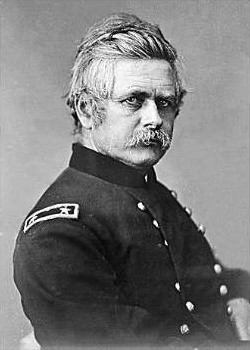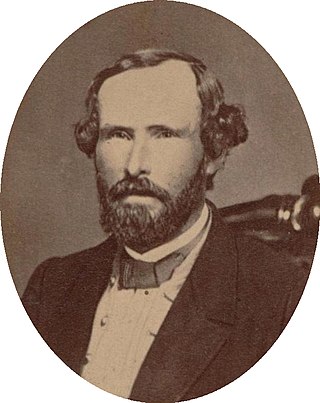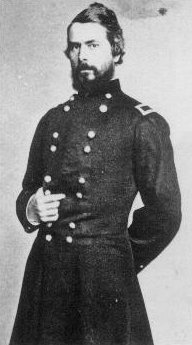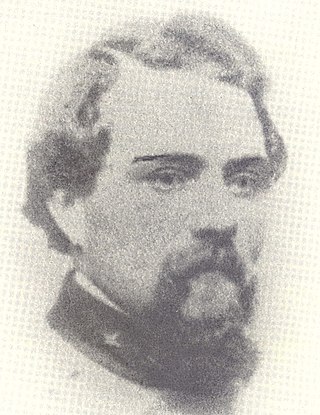Related Research Articles

Jefferson County is a county located in the Big Bend region in the northern part of the U.S. state of Florida. As of the 2020 census, the population was 14,510. Its county seat is Monticello.

Edward Otho Cresap Ord was an American engineer and United States Army officer who saw action in the Seminole War, the Indian Wars, and the American Civil War. He commanded an army during the final days of the Civil War, and was instrumental in forcing the surrender of Confederate General Robert E. Lee. He also designed Fort Sam Houston. He died in Havana, Cuba of yellow fever.

George Wythe Randolph was a Virginia lawyer, planter, politician and Confederate general. After representing the City of Richmond during the Virginia Secession Convention in 1861, during eight months in 1862 he was the Confederate States Secretary of War during the American Civil War, then served in the Virginia Senate representing the City of Richmond until the war's end.

Henry Lee III was an early American Patriot and U.S. politician who served as the ninth Governor of Virginia and as the Virginia Representative to the United States Congress. Lee's service during the American Revolution as a cavalry officer in the Continental Army earned him the nickname by which he is best known, "Light-Horse Harry". He was the father of Robert E. Lee, who led the Army of Northern Virginia against the Union Army during the American Civil War.

Eppa Hunton II was a Virginia lawyer and soldier who rose to become a brigadier general in the Confederate Army during the American Civil War. After the war, he served as a Democrat in both the United States House of Representatives and then the United States Senate from Virginia.

Thomas Fenwick Drayton was a planter, politician, railroad president, slave owner and military officer from Charleston, South Carolina. He served in the United States Army and then as a brigadier general in the Confederate States Army during the American Civil War. His brother, Percival Drayton, was a Naval Officer and fought on the Union side during the war.

Truman Seymour was a career soldier and an accomplished painter. He served in the Union Army during the American Civil War, rising to the rank of major general. He was present at the Battle of Fort Sumter. He commanded the Union troops at the Battle of Olustee, the only major Civil War battle fought in Florida.

Thomas Henry Carter was an artillery officer in the Confederate States Army during the American Civil War. His battalion played an important role in the Battle of Gettysburg.

Stephen Hinsdale Weed was a career military officer in the United States Army. He was killed defending Little Round Top during the Battle of Gettysburg in the American Civil War.

Florida participated in the American Civil War as a member of the Confederate States of America. It had been admitted to the United States as a slave state in 1845. In January 1861, Florida became the third Southern state to secede from the Union after the November 1860 presidential election victory of Abraham Lincoln. It was one of the initial seven slave states which formed the Confederacy on February 8, 1861, in advance of the American Civil War.

Samuel Gibbs French was an American military officer from New Jersey. He graduated from the United States Military Academy in 1843, served as a captain in the U.S. Army in the Mexican-American War, and was wounded at the Battle of Buena Vista. In 1856, he resigned his commission to manage a plantation in Mississippi he obtained through marriage.

Adam Stephen was a Scottish-born American doctor and military officer who helped found what became Martinsburg, West Virginia. He emigrated to North America, where he served in the Province of Virginia's militia under George Washington during the French and Indian War. He served under Washington again in the American Revolutionary War, rising to lead a division of the Continental Army. After a friendly fire incident during the Battle of Germantown, Stephen was cashiered out of the army, but continued as a prominent citizen of western Virginia, including terms in the Virginia General Assembly representing Berkeley County.

Arnold Elzey Jones Jr., known for much of his life simply as Arnold Elzey, was a soldier in both the United States Army and the Confederate Army, serving as a major general in the American Civil War. At First Manassas, he became one of the few officers ever to receive an on-the-field promotion to general by President Jefferson Davis. He commanded a brigade in Stonewall Jackson's Valley Campaign, and was badly wounded at Gaines Mill, ending his active field career.

As a fervently abolitionist and strongly Republican state, Maine contributed a higher proportion of its citizens to the Union armies than any other, as well as supplying money, equipment and stores. No land battles were fought in Maine. The only episode was the Battle of Portland Harbor (1863) that saw a Confederate raiding party thwarted in its attempt to capture a revenue cutter.

John Henry Winder was a career United States Army officer who served with distinction during the Mexican–American War. He later served as a Confederate general officer during the American Civil War.

Jubal Anderson Early was an American lawyer, politician and military officer who served in the Confederate States Army during the Civil War. Trained at the United States Military Academy, Early resigned his United States Army commission after the Second Seminole War and his Virginia military commission after the Mexican–American War, in both cases to practice law and participate in politics. Accepting a Virginia and later Confederate military commission as the American Civil War began, Early fought in the Eastern Theater throughout the conflict. He commanded a division under Generals Stonewall Jackson and Richard S. Ewell, and later commanded a corps.

Robert Archelaus Hardaway was an artillery officer in the Confederate Army of Northern Virginia during the American Civil War.
Hispanics in the American Civil War fought on both the Union and Confederate sides of the conflict. Not all the Hispanics who fought in the American Civil War were "Hispanic-Americans", in other words citizens of the United States. Many of them were Spanish subjects or nationals from countries in the Caribbean, Central and South America. Some were born in a US Territory and therefore did not have the right to US Citizenship. It is estimated that approximately 20,000 Hispanics, mostly Mexican-Americans, Puerto Ricans and Cubans living in the United States joined the war: 2,500 for the Confederacy and 1,000 for the Union. This number increased to 10,000 by the end of the war.

William Lauderdale was an American planter-soldier from a prominent Virginia family. He served in both the War of 1812 and the Seminole Wars.

Carter Moore Braxton Jr. (1836–1898) was an American civil engineer and businessman in the Hampton Roads area of Virginia, and a Confederate artillery officer, rising to the rank of lieutenant colonel during the American Civil War.
References
- ↑ "The War of the Rebellion: A Compilation of the Official Records of the Union and Confederate Armies: Prepared by the Late Lieut. Col. Robert N. Scott, Third U. S. Artillery. Published Under the Directions of the Hon. Redfield Proctor, Secretary of War, by Maj. George B. Davis, U. S. A., Mr. Leslie J. Perry, Mr. Joseph W. Kirkley, Board of Publication. Series I - Volume XXXV - in Two Parts. Part I - Reports, Correspondence, Etc". 1891.